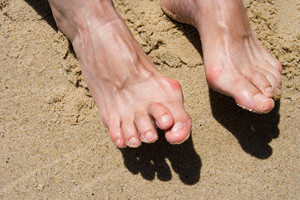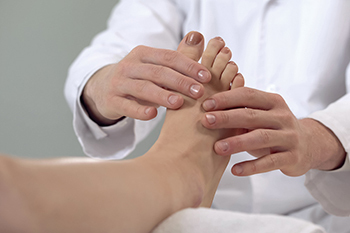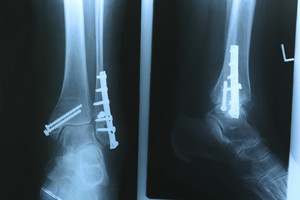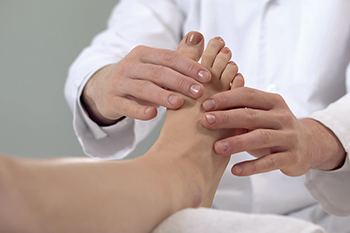Connect With Us
Blog
Items filtered by date: September 2022
Which Toes Does Hammertoe Affect?

The foot condition known as hammertoe is unsightly and it’s considered to be a deformity. Hammertoe affects the middle joints in the second, third, or fourth toes and can cause the toes to bend downward, resembling a hammer. It happens as a result of a muscle imbalance which may occur due to genetic reasons or from wearing shoes that do not have adequate room for the toes to move freely in. The toes look crooked and may be reversed in mild cases. When the toe remains flexible, it may be straightened by pressing on the affected joint. In severe cases, the toes become rigid, and surgery is often necessary for permanent straightening. Some patients develop a hammertoe from stubbing their toe and this can push the tissues at the joint out of alignment. If you have developed a hammertoe, it is suggested that you consult a podiatrist for a proper diagnosis as well as treatment options that are best for you.
Hammertoes can be a painful condition to live with. For more information, contact Philip K. Schrumpf, DPM of Active Feet Clinic. Our doctor will answer any of your foot- and ankle-related questions.
Hammertoe
Hammertoe is a foot deformity that occurs due to an imbalance in the muscles, tendons, or ligaments that normally hold the toe straight. It can be caused by the type of shoes you wear, your foot structure, trauma, and certain disease processes.
Symptoms
- Painful and/or difficult toe movement
- Swelling
- Joint stiffness
- Calluses/Corns
- Physical deformity
Risk Factors
- Age – The risk of hammertoe increases with age
- Sex – Women are more likely to have hammertoe compared to men
- Toe Length – You are more likely to develop hammertoe if your second toe is longer than your big toe
- Certain Diseases – Arthritis and diabetes may make you more likely to develop hammertoe
Treatment
If you have hammertoe, you should change into a more comfortable shoe that provides enough room for your toes. Exercises such as picking up marbles may strengthen and stretch your toe muscles. Nevertheless, it is important to seek assistance from a podiatrist in order to determine the severity of your hammertoe and see which treatment option will work best for you.
If you have any questions, please feel free to contact our office located in Missoula, MT . We offer the newest diagnostic and treatment technologies for all your foot care needs.
Which Toes Does Hammertoe Affect?

The foot condition known as hammertoe is unsightly and it’s considered to be a deformity. Hammertoe affects the middle joints in the second, third, or fourth toes and can cause the toes to bend downward, resembling a hammer. It happens as a result of a muscle imbalance which may occur due to genetic reasons or from wearing shoes that do not have adequate room for the toes to move freely in. The toes look crooked and may be reversed in mild cases. When the toe remains flexible, it may be straightened by pressing on the affected joint. In severe cases, the toes become rigid, and surgery is often necessary for permanent straightening. Some patients develop a hammertoe from stubbing their toe and this can push the tissues at the joint out of alignment. If you have developed a hammertoe, it is suggested that you consult a podiatrist for a proper diagnosis as well as treatment options that are best for you.
Hammertoes can be a painful condition to live with. For more information, contact Philip K. Schrumpf, DPM of Active Feet Clinic. Our doctor will answer any of your foot- and ankle-related questions.
Hammertoe
Hammertoe is a foot deformity that occurs due to an imbalance in the muscles, tendons, or ligaments that normally hold the toe straight. It can be caused by the type of shoes you wear, your foot structure, trauma, and certain disease processes.
Symptoms
- Painful and/or difficult toe movement
- Swelling
- Joint stiffness
- Calluses/Corns
- Physical deformity
Risk Factors
- Age – The risk of hammertoe increases with age
- Sex – Women are more likely to have hammertoe compared to men
- Toe Length – You are more likely to develop hammertoe if your second toe is longer than your big toe
- Certain Diseases – Arthritis and diabetes may make you more likely to develop hammertoe
Treatment
If you have hammertoe, you should change into a more comfortable shoe that provides enough room for your toes. Exercises such as picking up marbles may strengthen and stretch your toe muscles. Nevertheless, it is important to seek assistance from a podiatrist in order to determine the severity of your hammertoe and see which treatment option will work best for you.
If you have any questions, please feel free to contact our office located in Missoula, MT . We offer the newest diagnostic and treatment technologies for all your foot care needs.
Orthotics and Overpronation

Overpronation is a type of gait that occurs when an individual’s feet roll excessively downward or inward during movement. To mitigate overpronation, you might be able to use orthotics, which are shoe inserts that correct foot or gait abnormalities. If you have overpronation, you may benefit from using custom-made orthotics that are designed after conducting an analysis of your individual walking style and tendencies. In some cases, individuals who wore orthotics to correct their overpronation demonstrated better balance and even a reduction in pain. If you suspect that you have overpronation, contact a podiatrist (a foot specialist) who can determine whether wearing supportive orthotics can positively impact your gait.
If you are having discomfort in your feet and would like to try orthotics, contact Philip K. Schrumpf, DPM from Active Feet Clinic. Our doctor can provide the care you need to keep you pain-free and on your feet.
What Are Orthotics?
Orthotics are inserts you can place into your shoes to help with a variety of foot problems such as flat feet or foot pain. Orthotics provide relief and comfort for minor foot and heel pain but can’t correct serious biomechanical problems in your feet.
Over-the-Counter Inserts
Orthotics come in a wide variety of over-the-counter inserts that are used to treat foot pain, heel pain, and minor problems. For example, arch supports can be inserted into your shoes to help correct overarched or flat feet, while gel insoles are often used because they provide comfort and relief from foot and heel pain by alleviating pressure.
Prescription Orthotics
If over-the-counter inserts don’t work for you or if you have a more severe foot concern, it is possible to have your podiatrist prescribe custom orthotics. These high-quality inserts are designed to treat problems such as abnormal motion, plantar fasciitis, and severe forms of heel pain. They can even be used to help patients suffering from diabetes by treating foot ulcers and painful calluses and are usually molded to your feet individually, which allows them to provide full support and comfort.
If you are experiencing minor to severe foot or heel pain, it’s recommended to speak with your podiatrist about the possibilities of using orthotics. A podiatrist can determine which type of orthotic is right for you and allow you to take the first steps towards being pain-free.
If you have any questions please contact our office located in Missoula, MT . We offer the newest diagnostic and treatment technologies for all your foot and ankle needs.
Surgery for Ankle Fractures

An individual can break or fracture their ankle by experiencing different kinds of trauma, such as twisting ankle movements or injuries. If you have a fractured ankle, it is possible that the fracture is partial or complete in the affected bone. Additionally, the fracture may have developed where the ligament has been impacted. Sometimes, a medical professional will recommend undergoing a surgical procedure to treat a broken or fractured ankle if they believe that the injury will heal best with surgery. Particularly, if the fracture has spread to the joint in the ankle, a medical professional may recommend surgery. After undergoing a surgical procedure to treat a broken ankle, you may need to wear some sort of cast or splint for an extended period of time. This is largely dependent on the severity of your injury. You may also be instructed to limit the extent to which you put weight on the affected ankle. It is also possible that to continue to be mobile, you may have to use crutches following the surgery. If you have a broken ankle, contact a podiatrist who can assess your situation and discuss your options.
Broken ankles need immediate treatment. If you are seeking treatment, contact Philip K. Schrumpf, DPM from Active Feet Clinic. Our doctor can provide the care you need to keep you pain-free and on your feet.
Broken Ankles
A broken ankle is experienced when a person fractures their tibia or fibula in the lower leg and ankle area. Both of these bones are attached at the bottom of the leg and combine to form what we know to be our ankle.
When a physician is referring to a break of the ankle, he or she is usually referring to a break in the area where the tibia and fibula are joined to create our ankle joint. Ankles are more prone to fractures because the ankle is an area that suffers a lot of pressure and stress. There are some obvious signs when a person experiences a fractured ankle, and the following symptoms may be present.
Symptoms of a Fractured Ankle
- Excessive pain when the area is touched or when any pressure is placed on the ankle
- Swelling around the area
- Bruising of the area
- Area appears to be deformed
If you suspect an ankle fracture, it is recommended to seek treatment as soon as possible. The sooner you have your podiatrist diagnose the fracture, the quicker you’ll be on the way towards recovery.
If you have any questions, please feel free to contact our office located in Missoula, MT . We offer the newest diagnostic and treatment technologies for all your foot care needs.
Shoes for Specific Sporting Activities

It is beneficial to begin looking after your child’s feet when they are babies. There are simple measures that can help protect their feet as the growing process occurs. When toddlers begin to walk, it is beneficial to walk barefoot while inside as this can help to strengthen their overall foot as the toes grip the floor. When walking outside, the correct shoes need to be worn in the right size. When children get an adequate amount of exercise it helps keep the joints and muscles strong, in addition to improving circulation. Additionally, having your child eat healthy foods that have enough levels of vitamin D can help to maintain strong bones and support healthy connective tissue. There are specific shoes to wear for certain types of sporting activities. Shoes that have good support and cushioning can help the feet feel comfortable while engaging in strenuous sports. Having good arch support may help to prevent potential foot conditions. If you have concerns about your children’s feet and would like more information about the type of shoes they should wear, please consult with a podiatrist who can answer any questions you may have.
The health of a child’s feet is vital to their overall well-being. If you have any questions regarding foot health, contact Philip K. Schrumpf, DPM of Active Feet Clinic. Our doctor can provide the care you need to keep you pain-free and on your feet.
Tips for Keeping Children's Feet Healthy
- Make sure their shoes fit properly
- Look for any signs of in-toeing or out-toeing
- Check to see if they have Clubfoot (condition that affects your child’s foot and ankle, twisting the heel and toes inward) which is one of the most common nonmajor birth defects.
- Lightly cover your baby’s feet (Tight covers may keep your baby from moving their feet freely, and could prevent normal development)
- Allow your toddler to go shoeless (Shoes can be restricting for a young child’s foot)
- Cut toenails straight across to avoid ingrown toenails
- Keep your child’s foot clean and dry
- Cover cuts and scrapes. Wash any scratches with soap and water and cover them with a bandage until they’ve healed.
If you have any questions, please feel free to contact our office located in Missoula, MT . We offer the newest diagnostic and treatment technologies for all your foot care needs.
Do Your Child's Feet Hurt?
Blog Archives
- August 2024
- July 2024
- June 2024
- May 2024
- April 2024
- March 2024
- February 2024
- January 2024
- December 2023
- November 2023
- October 2023
- September 2023
- August 2023
- July 2023
- June 2023
- May 2023
- April 2023
- March 2023
- February 2023
- January 2023
- December 2022
- November 2022
- October 2022
- September 2022
- August 2022
- July 2022
- June 2022
- May 2022
- April 2022
- March 2022
- February 2022
- January 2022
- December 2021
- November 2021
- October 2021
- September 2021
- August 2021
- July 2021
- June 2021
- May 2021
- April 2021
- March 2021
- February 2021
- January 2021
- December 2020
- November 2020
- October 2020
- September 2020
- August 2020
- July 2020
- June 2020
- May 2020
- April 2020
- March 2020
- February 2020
- January 2020
- December 2019
- November 2019
- October 2019
- September 2019
- August 2019
- July 2019
- June 2019
- May 2019
- April 2019
- March 2019

